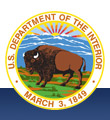Date: August 21, 2009
Contacts: Hugh Vickery
(202) 208-6416
GRAND CANYON NATIONAL PARK, AZ - Secretary of the Interior Ken Salazar today visited the Grand Canyon’s South Rim to highlight $10.8 million in projects under President Obama’s economic recovery package that are creating jobs and stimulating the local economy.
Projects at Grand Canyon National Park being funded [...]
 The National Park Service will invest $750 million in nearly 800 projects to stimulate the economy through the American Recovery and Reinvestment Act. Projects will preserve and protect national icons and historic landscapes, improve energy efficiency and renewable energy use, remediate abandoned mine lands, and provide $15 million in grants to protect and restore buildings at historically black colleges and universities. Additional funding through the Federal Highway Administration will improve park roads for millions of visitors.
The National Park Service will invest $750 million in nearly 800 projects to stimulate the economy through the American Recovery and Reinvestment Act. Projects will preserve and protect national icons and historic landscapes, improve energy efficiency and renewable energy use, remediate abandoned mine lands, and provide $15 million in grants to protect and restore buildings at historically black colleges and universities. Additional funding through the Federal Highway Administration will improve park roads for millions of visitors.
All projects are NPS priorities and meet the Recovery Act’s rigorous criteria of addressing highest mission needs, generating the largest number of jobs in the shortest period of time, and creating lasting value for the American people.
- Download a list of all National Park Service projects
 by state.
by state. - View the National Park Service investments by state.
Latest Video 

Available versions: QuickTime (MP4)
There are six types of projects:
Construction
Construction projects will build, rehabilitate, or replace facilities to help preserve natural and cultural resources and ensure safe, fun, and educational experiences for visitors.
Examples:
- Repair or replace critical infrastructure
- Upgrade facilities for health and safety
- Retrofit facilities for energy efficiency
- Install photovoltaic systems
- Demolish obsolete facilities
Deferred Maintenance
Deferred Maintenance projects will repair, rehabilitate, or maintain critical facilities to extend their useful life. The NPS will undertake major repair and rehabilitation work and will complete cyclic maintenance to prevent an increase in the maintenance backlog.
Examples:
- Replace heating, ventilation, and air conditioning equipment
- Replace utility, water, and wastewater systems
- Remove invasive plants
- Install fire suppression systems
- Stabilize historical structures
Energy Efficient Equipment Replacement
Energy efficient equipment replacement efforts will replace aging vehicles, heavy equipment, and HVAC systems with next generation energy efficient equipment. By reducing its fossil fuel consumption, the NPS will reduce its carbon footprint and fuel costs.
Examples:
- Purchase alternative fuel or hybrid transit buses
- Replace heating, cooling, water, and electrical equipment with energy efficient units
Trails
Trails projects will complete work to restore trails for safer use and to extend the life of trails across the national park system. In addition, trail work will provide opportunities for youth and young adults to participate in meaningful experiences on public lands and to contribute to the NPS mission.
Examples:
- Clear vegetation from trails
- Control erosion
- Replace deteriorated boardwalks
- Repair trail surfaces
Abandoned Mine Lands
The abandoned mine lands safety projects will remedy serious health and safety concerns at the sites. A consideration in choosing a particular remedy is the ability to provide continued use of the mine openings as wildlife habitat by maintaining access and airflow.
Examples:
- Design and install mine closures (blasting, fencing, safety cable nets)
- Restore habitat
Road Maintenance
Road maintenance projects will preserve park roads and parkways and rehabilitate deteriorated road networks. The NPS is responsible for approximately 5,450 paved miles of public park roads, 6,544 miles of unpaved roads, the equivalent of 948 paved miles of parking areas, and 1,679 structures such as bridges, culverts, and tunnels.
Examples:
- Seal roads
- Resurface and repave roads
- Correct erosion and drainage problems
- Repair culverts






